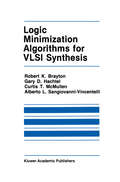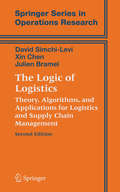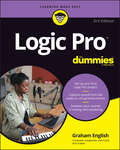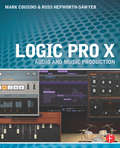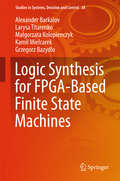- Table View
- List View
Logic Functions and Equations: Binary Models for Computer Science
by Christian Posthoff Bernd SteinbachLogic functions and equations are (some of) the most important concepts of Computer Science with many applications such as Binary Arithmetics, Coding, Complexity, Logic Design, Programming, Computer Architecture and Artificial Intelligence. They are very often studied in a minimum way prior to or together with their respective applications. Based on our long-time teaching experience, a comprehensive presentation of these concepts is given, especially emphasising a thorough understanding as well as numerical and computer-based solution methods. Any applications and examples from all the respective areas are given that can be dealt with in a unified way. They offer a broad understanding of the recent developments in Computer Science and are directly applicable in professional life. Logic Functions and Equations is highly recommended for a one- or two-semester course in many Computer Science or computer Science-oriented programmes. It allows students an easy high-level access to these methods and enables sophisticated applications in many different areas. It elegantly bridges the gap between Mathematics and the required theoretical foundations of Computer Science.
Logic Functions and Equations: Examples and Exercises
by Bernd Steinbach Christian PosthoffTsutomu Sasao – Kyushu Institute of Technology, Japan The material covered in this book is quite unique especially for p- ple who are reading English, since such material is quite hard to ?nd in the U.S. literature. German and Russian people have independently developed their theories, but such work is not well known in the U.S. societies. On the other hand, the theories developed in the U.S. are not conveyed to the other places. Thus, the same theory is re-invented or re-discovered in various places. For example, the switching theory was developed independently in the U.S., Europe, and Japan, almost at the same time [4, 18, 19]. Thus, the same notions are represented by di?- ent terminologies. For example, the Shegalkin polynomial is often called complement-free ring-sum, Reed-Muller expression [10], or Positive - larityReed-Mullerexpression [19].Anyway,itisquitedesirablethatsuch a unique book like this is written in English, and many people can read it without any di?culties. The authors have developed a logic system called XBOOLE.Itp- forms logical operations on the given functions. With XBOOLE, the readers can solve the problems given in the book. Many examples and complete solutions to the problems are shown, so the readers can study at home. I believe that the book containing many exercises and their solutions [9] is quite useful not only for the students, but also the p- fessors.
Logic Functions and Equations: Fundamentals and Applications using the XBOOLE-Monitor
by Bernd Steinbach Christian PosthoffThe greatly expanded and updated 3rd edition of this textbook offers the reader a comprehensive introduction to the concepts of logic functions and equations and their applications across computer science and engineering. The authors’ approach emphasizes a thorough understanding of the fundamental principles as well as numerical and computer-based solution methods. The book provides insight into applications across propositional logic, binary arithmetic, coding, cryptography, complexity, logic design, and artificial intelligence.Updated throughout, some major additions for the 3rd edition include:a new chapter about the concepts contributing to the power of XBOOLE;a new chapter that introduces into the application of the XBOOLE-Monitor XBM 2;many tasks that support the readers in amplifying the learned content at the end of the chapters;solutions of a large subset of these tasks to confirm learning success;challenging tasks that need the power of the XBOOLE software for their solution.The XBOOLE-monitor XBM 2 software is used to solve the exercises; in this way the time-consuming and error-prone manipulation on the bit level is moved to an ordinary PC, more realistic tasks can be solved, and the challenges of thinking about algorithms leads to a higher level of education.
Logic Locking: Ein praktischer Ansatz für sichere Hardware
by Rainer Leupers Dominik SisejkovicEine subtile Veränderung, die zu katastrophalen Folgen führt - Hardware-Trojaner stellen zweifellos eine der größten Sicherheitsbedrohungen des modernen Zeitalters dar. Wie kann die Hardware vor diesen bösartigen Veränderungen geschützt werden? Eine mögliche Lösung verbirgt sich im Logic Locking, einer bekannten Technik zur Verschleierung von Hardware. In diesem Buch gehen wir Schritt für Schritt vor, um Logic Locking zu verstehen, von seiner grundlegenden Mechanik über die Implementierung in Software bis hin zu einer eingehenden Analyse der Sicherheitseigenschaften im Zeitalter des maschinellen Lernens. Dieses Buch kann als Nachschlagewerk sowohl für Anfänger als auch für Experten verwendet werden, die in die Welt des logischen Sperrens eintauchen wollen und dabei einen ganzheitlichen Überblick über die gesamte Infrastruktur erhalten möchten, die für den Entwurf, die Bewertung und den Einsatz moderner Sperrstrategien erforderlich ist.
Logic Locking: A Practical Approach to Secure Hardware
by Dominik Sisejkovic Rainer LeupersA subtle change that leads to disastrous consequences—hardware Trojans undoubtedly pose one of the greatest security threats to the modern age. How to protect hardware against these malicious modifications? One potential solution hides within logic locking; a prominent hardware obfuscation technique. In this book, we take a step-by-step approach to understanding logic locking, from its fundamental mechanics, over the implementation in software, down to an in-depth analysis of security properties in the age of machine learning. This book can be used as a reference for beginners and experts alike who wish to dive into the world of logic locking, thereby having a holistic view of the entire infrastructure required to design, evaluate, and deploy modern locking policies.
Logic Minimization Algorithms for VLSI Synthesis (The Springer International Series in Engineering and Computer Science #2)
by Robert K. Brayton Gary D. Hachtel C. McMullen Alberto L. Sangiovanni-VincentelliThe roots of the project which culminates with the writing of this book can be traced to the work on logic synthesis started in 1979 at the IBM Watson Research Center and at University of California, Berkeley. During the preliminary phases of these projects, the impor tance of logic minimization for the synthesis of area and performance effective circuits clearly emerged. In 1980, Richard Newton stirred our interest by pointing out new heuristic algorithms for two-level logic minimization and the potential for improving upon existing approaches. In the summer of 1981, the authors organized and participated in a seminar on logic manipulation at IBM Research. One of the goals of the seminar was to study the literature on logic minimization and to look at heuristic algorithms from a fundamental and comparative point of view. The fruits of this investigation were surprisingly abundant: it was apparent from an initial implementation of recursive logic minimiza tion (ESPRESSO-I) that, if we merged our new results into a two-level minimization program, an important step forward in automatic logic synthesis could result. ESPRESSO-II was born and an APL implemen tation was created in the summer of 1982. The results of preliminary tests on a fairly large set of industrial examples were good enough to justify the publication of our algorithms. It is hoped that the strength and speed of our minimizer warrant its Italian name, which denotes both express delivery and a specially-brewed black coffee.
The Logic of Logistics: Theory, Algorithms, and Applications for Logistics Management (Springer Series in Operations Research and Financial Engineering)
by David Simchi-Levi Xin Chen Julien BramelFierce competition in today's global market provides a powerful motivation for developing ever more sophisticated logistics systems. This book, written for the logistics manager and researcher, presents a survey of the modern theory and application of logistics. The goal of the book is to present the state-of-the-art in the science of logistics management. As a result, the authors have written a timely and authoritative survey of this field that many practitioners and researchers will find makes an invaluable companion to their work.
The Logic of Logistics: Theory, Algorithms, and Applications for Logistics and Supply Chain Management (Springer Series in Operations Research and Financial Engineering)
by David Simchi-Levi Xin Chen Julien BramelFierce competition in today's global market provides a powerful motivation for developing ever more sophisticated logistics systems. This book, written for the logistics manager and researcher, presents a survey of the modern theory and application of logistics. The goal of the book is to present the state-of-the-art in the science of logistics management. As a result, the authors have written a timely and authoritative survey of this field that many practitioners and researchers will find makes an invaluable companion to their work.
Logic Pro For Dummies
by Graham EnglishThis one-stop source for Logic Pro insight helps you spend more time creating music Every minute you spend trying to figure out how to set up a new track or build a drum loop is a minute you don’t spend creating and recording your music. This guide to the recording software favored by Mac users helps you bypass the time needed to search for tech answers and spend more time capturing sounds. Discover the full recording power of Logic Pro, starting with launching a project and recording your audio. Explore the built-in digital instruments and beat makers, augment your recording power with plug-ins, and finalize your song by editing, adding effects, mixing, mastering, and sharing. The final step is music stardom! Learn your way around the Logic Pro interface and understand the workflow Set up your project and add tracks and regions Record acoustic audio or conduct your orchestra of MIDI instruments Edit, mix, automate, export, and feel proud of your audio filesFor beginning music creators and producers, this Dummies guide makes it simple to get started with Logic Pro.
Logic Pro For Dummies
by Graham EnglishThis one-stop source for Logic Pro insight helps you spend more time creating music Every minute you spend trying to figure out how to set up a new track or build a drum loop is a minute you don’t spend creating and recording your music. This guide to the recording software favored by Mac users helps you bypass the time needed to search for tech answers and spend more time capturing sounds. Discover the full recording power of Logic Pro, starting with launching a project and recording your audio. Explore the built-in digital instruments and beat makers, augment your recording power with plug-ins, and finalize your song by editing, adding effects, mixing, mastering, and sharing. The final step is music stardom! Learn your way around the Logic Pro interface and understand the workflow Set up your project and add tracks and regions Record acoustic audio or conduct your orchestra of MIDI instruments Edit, mix, automate, export, and feel proud of your audio filesFor beginning music creators and producers, this Dummies guide makes it simple to get started with Logic Pro.
Logic Pro X: Audio and Music Production
by Mark Cousins Russ Hepworth-SawyerFrom initial demos to mixing and mastering, seasoned authors Mark Cousins and Russ Hepworth-Sawyer show you how to get the most from Logic Pro X. By exploring the essential workflow and the creative possibilities offered by Logic’s virtual instruments and effects, Logic Pro X: Audio and Music Production leads you through the music creation and production process, giving you all the tips and tricks used by the pros to create release-quality recordings. Using full color screenshots throughout, alongside related boxouts that expand on the key concepts, Logic Pro X: Audio and Music Production is an informative and easy-to-read guide to using Logic Pro X. Key features include: Production FAQs – Instructional Walkthroughs and Knowledgebases present information clearly and answer common production–specific problems. Methods – Professional techniques for recording and editing in Logic Pro X – whether you’re dealing with real musicians or cutting-edge virtual instruments. Workflow – Use Logic Pro X’s tools and functions in an optimal way. Website – Access audio examples, samples (Apple Loops), Logic projects, sampler instruments, and instrument patches at www.focalpress.com/cw/cousins Logic Pro X: Audio and Music Production covers more than just the software; it will help you make the most out of every recording session and will illuminate and inspire your creative and sonic endeavors!
Logic Pro X: Audio and Music Production
by Mark Cousins Russ Hepworth-SawyerFrom initial demos to mixing and mastering, seasoned authors Mark Cousins and Russ Hepworth-Sawyer show you how to get the most from Logic Pro X. By exploring the essential workflow and the creative possibilities offered by Logic’s virtual instruments and effects, Logic Pro X: Audio and Music Production leads you through the music creation and production process, giving you all the tips and tricks used by the pros to create release-quality recordings. Using full color screenshots throughout, alongside related boxouts that expand on the key concepts, Logic Pro X: Audio and Music Production is an informative and easy-to-read guide to using Logic Pro X. Key features include: Production FAQs – Instructional Walkthroughs and Knowledgebases present information clearly and answer common production–specific problems. Methods – Professional techniques for recording and editing in Logic Pro X – whether you’re dealing with real musicians or cutting-edge virtual instruments. Workflow – Use Logic Pro X’s tools and functions in an optimal way. Website – Access audio examples, samples (Apple Loops), Logic projects, sampler instruments, and instrument patches at www.focalpress.com/cw/cousins Logic Pro X: Audio and Music Production covers more than just the software; it will help you make the most out of every recording session and will illuminate and inspire your creative and sonic endeavors!
Logic Synthesis and Optimization (The Springer International Series in Engineering and Computer Science #212)
by Tsutomu SasaoLogic Synthesis and Optimization presents up-to-date research information in a pedagogical form. The authors are recognized as the leading experts on the subject. The focus of the book is on logic minimization and includes such topics as two-level minimization, multi-level minimization, application of binary decision diagrams, delay optimization, asynchronous circuits, spectral method for logic design, field programmable gate array (FPGA) design, EXOR logic synthesis and technology mapping. Examples and illustrations are included so that each contribution can be read independently. Logic Synthesis and Optimization is an indispensable reference for academic researchers as well as professional CAD engineers.
Logic Synthesis and SOC Prototyping: RTL Design using VHDL
by Vaibbhav TaraateThis book describes RTL design, synthesis, and timing closure strategies for SOC blocks. It covers high-level RTL design scenarios and challenges for SOC design. The book gives practical information on the issues in SOC and ASIC prototyping using modern high-density FPGAs. The book covers SOC performance improvement techniques, testing, and system-level verification. The book also describes the modern Xilinx FPGA architecture and their use in SOC prototyping. The book covers the Synopsys DC, PT commands, and use of them to constraint and to optimize SOC design. The contents of this book will be of use to students, professionals, and hobbyists alike.
Logic Synthesis and Verification (The Springer International Series in Engineering and Computer Science #654)
by Soha Hassoun Tsutomu SasaoResearch and development of logic synthesis and verification have matured considerably over the past two decades. Many commercial products are available, and they have been critical in harnessing advances in fabrication technology to produce today's plethora of electronic components. While this maturity is assuring, the advances in fabrication continue to seemingly present unwieldy challenges. Logic Synthesis and Verification provides a state-of-the-art view of logic synthesis and verification. It consists of fifteen chapters, each focusing on a distinct aspect. Each chapter presents key developments, outlines future challenges, and lists essential references. Two unique features of this book are technical strength and comprehensiveness. The book chapters are written by twenty-eight recognized leaders in the field and reviewed by equally qualified experts. The topics collectively span the field. Logic Synthesis and Verification fills a current gap in the existing CAD literature. Each chapter contains essential information to study a topic at a great depth, and to understand further developments in the field. The book is intended for seniors, graduate students, researchers, and developers of related Computer-Aided Design (CAD) tools. From the foreword: "The commercial success of logic synthesis and verification is due in large part to the ideas of many of the authors of this book. Their innovative work contributed to design automation tools that permanently changed the course of electronic design." by Aart J. de Geus, Chairman and CEO, Synopsys, Inc.
Logic Synthesis and Verification Algorithms
by Gary D. Hachtel Fabio SomenziLogic Synthesis and Verification Algorithms is a textbook designed for courses on VLSI Logic Synthesis and Verification, Design Automation, CAD and advanced level discrete mathematics. It also serves as a basic reference work in design automation for both professionals and students. Logic Synthesis and Verification Algorithms is about the theoretical underpinnings of VLSI (Very Large Scale Integrated Circuits). It combines and integrates modern developments in logic synthesis and formal verification with the more traditional matter of Switching and Finite Automata Theory. The book also provides background material on Boolean algebra and discrete mathematics. A unique feature of this text is the large collection of solved problems. Throughout the text the algorithms covered are the subject of one or more problems based on the use of available synthesis programs.
Logic Synthesis for Asynchronous Controllers and Interfaces (Springer Series in Advanced Microelectronics #8)
by J. Cortadella M. Kishinevsky A. Kondratyev Luciano Lavagno Alex YakovlevThis book is the result of a long friendship, of a broad international co operation, and of a bold dream. It is the summary of work carried out by the authors, and several other wonderful people, during more than 15 years, across 3 continents, in the course of countless meetings, workshops and discus sions. It shows that neither language nor distance can be an obstacle to close scientific cooperation, when there is unity of goals and true collaboration. When we started, we had very different approaches to handling the mys terious, almost magical world of asynchronous circuits. Some were more theo retical, some were closer to physical reality, some were driven mostly by design needs. In the end, we all shared the same belief that true Electronic Design Automation research must be solidly grounded in formal models, practically minded to avoid excessive complexity, and tested "in the field" in the form of experimental tools. The results are this book, and the CAD tool petrify. The latter can be downloaded and tried by anybody bold (or desperate) enough to tread into the clockless (but not lawless) domain of small-scale asynchronicity. The URL is http://www.lsi. upc. esr j ordic/petrify. We believe that asynchronous circuits are a wonderful object, that aban dons some of the almost militaristic law and order that governs synchronous circuits, to improve in terms of simplicity, energy efficiency and performance.
Logic Synthesis for Compositional Microprogram Control Units (Lecture Notes in Electrical Engineering #22)
by Alexander Barkalov Larysa TitarenkoOne of the very important parts of any digital system is the control unit, coordin- ing interplay of other system blocks. As a rule, control units have irregular str- ture, which makes process of their logic circuits design very sophisticated. In case of complex logic controllers, the problem of system design is reduced practically to the design of control units. Actually, we observe a real technical boom connected with achievements in semiconductor technology. One of these is the development of integrated circuit known as the "systems-on-a-programmable- chip" (SoPC), where the number of elements approaches one billion. Because of the extreme complexity of microchips, it is very important to develop effective design methods oriented on particular properties of logical elements. Solution of this problem permits impr- ing functional capabilities of the target digital system inside single SoPC chip. As majority of researches point out, design methods used in case of industrial packages are, in case of complex digital system design, far from optimal. Similar problems concern the design of control units with standard ?eld-programmable logic devices (FPLD), such as PLA, PAL, GAL, CPLD, and FPGA. Let us point out that modern SoPC are based on CPLD or FPGA technology. Thus, the development of eff- tive design methods oriented on FPLD implementation of logic circuits used in the control units still remains the problem of great importance.
Logic Synthesis for Control Automata
by Samary BaranovLogic Synthesis for Control Automata provides techniques for logic design of very complex control units with hardly any constraints on their size, i.e. the number of inputs, outputs and states. These techniques cover all stages of control unit design, including: description of control unit behavior by using operator schemes of algorithms (binary decision trees) and various transformations of these descriptions -- composition, decomposition, minimization, etc.; synthesis of a control automaton (finite-state machine); synthesis of an automaton logic circuit: with matrix structure as a part of LSI or VLSI circuits; as multilevel circuit with logic gates; with standard LSI and VLSI circuits with and without memory. Each chapter contains many examples, illustrating the use of the models and methods described. Moreover, the special last chapter demonstrates in detail the whole design methodology presented in the previous chapters, through the examples of the logic design for a control unit. The models, methods and algorithms described in the book can be applied to a broad class of digital system design problems including design of complex controllers, robots, control units of computers and for designing CAD systems of VLSI circuits using FPGA, PLD and SIC technologies. Logic Synthesis for Control Automata is a valuable reference for graduate students, researchers and engineers involved in the design of very complex controllers, VLSI circuits and CAD systems. The inclusion of many examples and problems makes it most suitable for a course on the subject.
Logic Synthesis for Field-Programmable Gate Arrays (The Springer International Series in Engineering and Computer Science #324)
by Rajeev Murgai Robert K. Brayton Alberto L. Sangiovanni-VincentelliShort turnaround has become critical in the design of electronic systems. Software- programmable components such as microprocessors and digital signal processors have been used extensively in such systems since they allow rapid design revisions. However, the inherent performance limitations of software-programmable systems mean that they are inadequate for high-performance designs. Designers thus turned to gate arrays as a solution. User-programmable gate arrays (field-programmable gate arrays, FPGAs) have recently emerged and are changing the way electronic systems are designed and implemented. The growing complexity of the logic circuits that can be packed onto an FPGA chip means that it has become important to have automatic synthesis tools that implement logic functions on these architectures. Logic Synthesis for Field-Programmable Gate Arrays describes logic synthesis for both look-up table (LUT) and multiplexor-based architectures, with a balanced presentation of existing techniques together with algorithms and the system developed by the authors. Audience: A useful reference for VLSI designers, developers of computer-aided design tools, and anyone involved in or with FPGAs.
Logic Synthesis for Finite State Machines Based on Linear Chains of States: Foundations, Recent Developments and Challenges (Studies in Systems, Decision and Control #113)
by Alexander Barkalov Larysa Titarenko Jacek BieganowskiThis book discusses Moore finite state machines (FSMs) implemented with field programmable gate arrays (FPGAs) including look-up table (LUT) elements and embedded memory blocks (EMBs). To minimize the number of LUTs in FSM logic circuits, the authors propose replacing a state register with a state counter. They also put forward an approach allowing linear chains of states to be created, which simplifies the system of input memory functions and, therefore, decreases the number of LUTs in the resulting FSM circuit. The authors combine this approach with using EMBs to implement the system of output functions (microoperations). This allows a significant decrease in the number of LUTs, as well as eliminating a lot of interconnections in the FSM logic circuit. As a rule, it also reduces the area occupied by the circuit and diminishes the resulting power dissipation.This book is an interesting and valuable resource for students and postgraduates in the area of computer science, as well as for designers of digital systems that included complex control units
Logic Synthesis for FPGA-Based Control Units: Structural Decomposition in Logic Design (Lecture Notes in Electrical Engineering #636)
by Alexander Barkalov Larysa Titarenko Kamil Mielcarek Sławomir ChmielewskiThis book focuses on control units, which are a vital part of modern digital systems, and responsible for the efficiency of controlled systems. The model of a finite state machine (FSM) is often used to represent the behavior of a control unit. As a rule, control units have irregular structures that make it impossible to design their logic circuits using the standard library cells. Design methods depend strongly on such factors as the FSM used, specific features of the logic elements implemented in the FSM logic circuit, and the characteristics of the control algorithm to be interpreted.This book discusses Moore and Mealy FSMs implemented with FPGA chips, including look-up table elements (LUT) and embedded memory blocks (EMB). It is crucial to minimize the number of LUTs and EMBs in an FSM logic circuit, as well as to make the interconnections between the logic elements more regular, and various methods of structural decompositions can be used to solve this problem. These methods are reduced to the presentation of an FSM circuit as a composition of different logic blocks, the majority of which implement systems of intermediate logic functions different (and much simpler) than input memory functions and FSM output functions. The structural decomposition results in multilevel FSM circuits having fewer logic elements than equivalent single-level circuits. The book describes well-known methods of structural decomposition and proposes new ones, examining their impact on the final amount of hardware in an FSM circuit. It is of interest to students and postgraduates in the area of Computer Science, as well as experts involved in designing digital systems with complex control units. The proposed models and design methods open new possibilities for creating logic circuits of control units with an optimal amount of hardware and regular interconnections.
Logic Synthesis for FPGA-Based Finite State Machines (Studies in Systems, Decision and Control #38)
by Alexander Barkalov Larysa Titarenko Malgorzata Kolopienczyk Kamil Mielcarek Grzegorz BazydloThis book discusses control units represented by the model of a finite state machine (FSM). It contains various original methods and takes into account the peculiarities of field-programmable gate arrays (FPGA) chips and a FSM model. It shows that one of the peculiarities of FPGA chips is the existence of embedded memory blocks (EMB). The book is devoted to the solution of problems of logic synthesis and reduction of hardware amount in control units. The book will be interesting and useful for researchers and PhD students in the area of Electrical Engineering and Computer Science, as well as for designers of modern digital systems.
Logic Synthesis for FSM-Based Control Units (Lecture Notes in Electrical Engineering #53)
by Alexander Barkalov Larysa TitarenkoLogic Synthesis for Genetic Diseases: Modeling Disease Behavior Using Boolean Networks
by Pey-Chang Kent Lin Sunil P. KhatriThis book brings to bear a body of logic synthesis techniques, in order to contribute to the analysis and control of Boolean Networks (BN) for modeling genetic diseases such as cancer. The authors provide several VLSI logic techniques to model the genetic disease behavior as a BN, with powerful implicit enumeration techniques. Coverage also includes techniques from VLSI testing to control a faulty BN, transforming its behavior to a healthy BN, potentially aiding in efforts to find the best candidates for treatment of genetic diseases.





